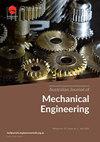Numerical assessment of temperature and stresses in friction stir welding of dissimilar Mg-Al-Zn alloys
IF 1.3
Q3 ENGINEERING, MECHANICAL
Australian Journal of Mechanical Engineering
Pub Date : 2023-09-28
DOI:10.1080/14484846.2023.2259725
引用次数: 0
Abstract
ABSTRACTMagnesium (Mg) alloys are used more frequently as a replacement for heavier structural materials because of their advantageous specific strength and eco-friendly attributes. Their fusion welding is a difficult process, but the friction stir welding (FSW) offers a potential solution to these issues. In this study, a thermal analysis is carried out to obtain the temperature distribution and residual stresses related to FSW of different Mg-Al-Zn series Mg alloys under different processing conditions. The highest temperature recorded at the centre of the weld was 544.04°C, while the average von Mises stress during welding was 185.07 MPa. These values were achieved with a tool rotational speed of 1000 rpm, welding speed of 40 mm/min, and a tool shoulder diameter of 21 mm. The temperatures obtained through the numerical model were validated by comparing them with experimental data. During the experimental analysis, small cracks were observed at the centre of the welded joint, resulting from the formation of MgO. The welded joint exhibited a maximum tensile strength of 234.86 MPa, which is approximately 90% of the stronger AZ31 Mg alloy.KEYWORDS: Dissimilar magnesium alloystemperatureresidual stressesmicrostructuretensile strengthfriction stir weldingthermal analysis AcknowledgementsAuthors would like to acknowledge the research assistantship provided by UGC New Delhi, India, and MNNIT Allahabad, Prayagraj, U.P., India (under TEQIP-III scheme).Disclosure statementNo potential conflict of interest was reported by the author(s).Additional informationNotes on contributorsUmesh Kumar SinghUmesh Kumar Singh earned his M.Tech. and Ph.D. from Motilal Nehru National Institute of Technology Allahabad, Prayagraj (Uttar Pradesh), India. He has published research articles in various refereed International Journals and Conferences. His are of research is Friction Stir Welding.Avanish Kumar DubeyAvanish Kumar Dubey earned his M.Tech. and Ph.D. from Motilal Nehru National Institute of Technology Allahabad, Prayagraj (Uttar Pradesh), India. He has published many research articles in various refereed International and National Journals and Conferences. Currently, he is working as a Professor in the Department of Mechanical Engineering, Motilal Nehru National Institute of Technology Allahabad, Prayagraj (Uttar Pradesh), India. His areas of interests are Laser Material Processing and Advanced Manufacturing Processes, Modeling and Optimization of Manufacturing Processes.不同Mg-Al-Zn合金搅拌摩擦焊接温度和应力的数值计算
摘要镁合金因其优越的比强度和环保特性,越来越多地被用作较重的结构材料的替代品。它们的熔焊是一个困难的过程,但搅拌摩擦焊(FSW)提供了一个潜在的解决方案。本研究对不同Mg- al - zn系镁合金在不同加工条件下的摩擦摩擦相关温度分布和残余应力进行了热分析。焊缝中心记录的最高温度为544.04℃,焊接过程中的平均von Mises应力为185.07 MPa。这些值是在刀具转速为1000 rpm,焊接速度为40 mm/min,工具肩直径为21 mm的情况下实现的。通过与实验数据的比较,验证了数值模型所得温度的正确性。在实验分析中,在焊接接头中心观察到细小的裂纹,这是由MgO的形成引起的。焊接接头的最大抗拉强度为234.86 MPa,约为强AZ31镁合金的90%。关键词:异种镁合金,系统温度,残余应力,显微组织,拉伸强度,搅拌摩擦焊接,热分析。作者感谢UGC新德里,印度和MNNIT阿拉哈巴德,Prayagraj, U.P,印度(TEQIP-III计划下)提供的研究资助。披露声明作者未报告潜在的利益冲突。关于贡献者的说明humesh Kumar Singh获得了他的M.Tech。毕业于印度Prayagraj (Uttar Pradesh)阿拉哈巴德的Motilal Nehru国立理工学院。他在各种国际期刊和会议上发表了研究论文。他的研究方向是搅拌摩擦焊。Avanish Kumar Dubey获得了技术硕士学位。毕业于印度Prayagraj (Uttar Pradesh)阿拉哈巴德的Motilal Nehru国立理工学院。他在各种国际和国家期刊和会议上发表了许多研究文章。目前,他在印度Prayagraj (Uttar Pradesh)阿拉哈巴德的Motilal Nehru国立理工学院机械工程系担任教授。他的兴趣领域是激光材料加工和先进制造工艺,制造工艺建模和优化。
本文章由计算机程序翻译,如有差异,请以英文原文为准。
求助全文
约1分钟内获得全文
求助全文
来源期刊

Australian Journal of Mechanical Engineering
ENGINEERING, MECHANICAL-
CiteScore
3.70
自引率
7.10%
发文量
77
 求助内容:
求助内容: 应助结果提醒方式:
应助结果提醒方式:


